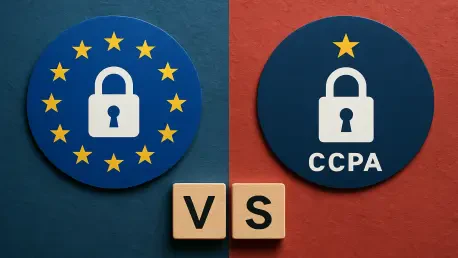In an era where data breaches expose millions of personal records annually, with over 2.6 billion personal data points compromised in a single year according to recent studies, the urgency for robust privacy protections has never been more evident, especially when imagining a world where every click, purchase, or search could be exploited without consent. Such is the reality for many without stringent regulations. This pressing challenge brings into focus two landmark frameworks: the General Data Protection Regulation (GDPR) from the European Union and the California Consumer Privacy Act (CCPA) from the United States. Both aim to shield individuals from data misuse, yet they differ in scope, approach, and impact. This comparison delves into how these regulations shape the landscape of data privacy, offering a lens into their strengths and challenges for businesses and consumers alike.
Key Differences and Similarities in Framework and Scope
Scope and Applicability
The jurisdictional reach of GDPR and CCPA marks a fundamental distinction in their application. GDPR, enacted by the EU, extends its protection to any organization processing data of EU citizens, regardless of the company’s geographic location. This global applicability means a tech startup in Asia or a retailer in South America must comply if they handle EU data. In contrast, CCPA targets businesses operating in California that meet specific thresholds, such as annual revenue over $25 million or handling data of 50,000 or more California residents. Its influence, though state-specific, often ripples nationally due to California’s economic weight.
Beyond geographic scope, the protected populations differ significantly. GDPR safeguards all individuals within the EU, whether citizens or residents, ensuring a broad safety net across 27 member states. CCPA, however, focuses solely on California residents, leaving out non-residents even if they interact with California-based firms. This narrower focus can create gaps for businesses dealing with a diverse U.S. customer base. For instance, a multinational corporation like a social media giant must navigate GDPR’s worldwide mandates, while a regional e-commerce platform in California primarily contends with CCPA’s criteria.
Consumer Rights and Protections
When examining consumer rights, GDPR offers a more expansive set of protections compared to CCPA. Under GDPR, individuals can access their data, request corrections, demand erasure through the “right to be forgotten,” and even transfer their data to another service via data portability. These rights empower users to control nearly every aspect of their personal information. CCPA, while significant, emphasizes transparency and choice, granting California residents the right to know what data is collected, request deletion, and opt out of data sales, but it lacks provisions like data portability or rectification.
The depth of control also varies between the two. GDPR’s framework places individuals at the center, requiring companies to justify data usage and often seek explicit consent before processing. This creates a proactive shield against misuse. CCPA, on the other hand, leans toward reactive measures, focusing on informing consumers after data collection and allowing opt-outs rather than preemptive consent. For example, a user under GDPR might block data processing upfront, while a CCPA-protected resident might only act after discovering their data has been sold.
Real-world implications highlight these differences further. Both regulations allow data deletion requests, but GDPR’s process is often more stringent, requiring companies to erase data across all systems unless legally obligated to retain it. CCPA’s deletion right, while powerful, can be limited by exceptions such as completing a transaction. Consumers navigating these systems may find GDPR’s broader protections more reassuring, though CCPA’s opt-out mechanism offers a practical tool against targeted advertising.
Business Obligations and Enforcement
Compliance requirements under GDPR and CCPA impose distinct burdens on organizations. GDPR mandates a proactive approach with principles like data protection by design and default, meaning privacy must be embedded into systems from the outset. Certain entities must also appoint Data Protection Officers to oversee compliance. CCPA, conversely, focuses on transparency, requiring businesses to disclose data practices clearly and provide accessible opt-out options, but it lacks the same depth of structural mandates as GDPR.
Enforcement mechanisms reveal another layer of contrast. GDPR’s penalties are notably severe, with fines up to 4% of a company’s global annual revenue or €20 million, whichever is higher, enforced by national Data Protection Authorities. High-profile cases have seen tech giants slapped with multimillion-euro fines for breaches. CCPA, enforced by the California Attorney General, caps fines at $7,500 per intentional violation, appearing less daunting. However, its cumulative impact can still sting, especially for smaller firms, though initial enforcement showed some leniency to encourage adaptation.
Implementation timelines and penalty structures also diverge. GDPR, effective since 2018, gave businesses a clear runway to adjust, yet its complexity often catches firms off-guard even years later. CCPA, rolled out in 2020, offered a shorter adjustment period, with amendments like the California Privacy Rights Act expanding its scope over time. These differences mean a European branch of a corporation might face immediate GDPR scrutiny, while a California-focused entity could leverage CCPA’s evolving guidelines for gradual compliance.
Challenges and Limitations in Compliance
The path to GDPR compliance often presents steep hurdles for businesses. High costs associated with overhauling data systems, ensuring cross-border data transfer security, and maintaining ongoing vigilance against regulatory updates can strain resources. Multinational firms, for instance, must align operations across diverse legal landscapes, a task complicated by evolving EU interpretations of data rules. Smaller enterprises, lacking dedicated legal teams, frequently struggle to keep pace with these demands.
CCPA introduces its own set of challenges, particularly around clarity and scope. Ambiguities in defining terms like “personal information” can leave businesses uncertain about compliance boundaries, risking unintentional violations. Additionally, smaller California-based companies often find the cost of implementing data disclosure and opt-out systems disproportionate to their revenue. Unlike GDPR’s uniform EU-wide enforcement, CCPA’s state-specific nature adds complexity for firms operating across multiple U.S. states with varying privacy laws.
Broader issues affect both frameworks, such as balancing compliance expenses with profitability. Training employees on data privacy protocols remains a persistent concern, as does meeting consumer expectations for transparency and security. Emerging technologies like the Internet of Things and artificial intelligence further complicate matters, introducing new data vulnerabilities. Businesses must constantly adapt to these innovations, ensuring that vast datasets handled by AI or IoT devices remain protected under either GDPR’s strict oversight or CCPA’s transparency rules.
Conclusion and Recommendations for Businesses
Reflecting on the journey through GDPR and CCPA, it becomes clear that while both aim to fortify data privacy, their approaches diverge in ambition and execution. GDPR stands out with its sweeping global reach and rigorous standards, setting a benchmark that reshapes how companies worldwide view data protection. CCPA, though regionally focused, carves a vital path for U.S. privacy laws, pushing consumer transparency to the forefront in California and beyond.
Looking ahead, businesses must prioritize strategic alignment with these frameworks to stay competitive and compliant. For those with international operations, embedding GDPR principles offers a robust foundation that often covers CCPA requirements as a byproduct. U.S.-based firms, especially those engaging California consumers, need to tailor systems for CCPA’s specific mandates to avoid penalties and foster trust. Investing in scalable privacy tools and regular staff training emerges as an essential step to navigate both landscapes.
Ultimately, the evolving nature of data privacy signals a need for agility. Companies are encouraged to monitor legislative trends, such as potential federal U.S. privacy laws or tighter EU regulations, to anticipate shifts. Building a culture of privacy not only mitigates risks but also positions organizations as leaders in a data-driven world, ready to adapt to harmonized global standards that might emerge in the years ahead.









